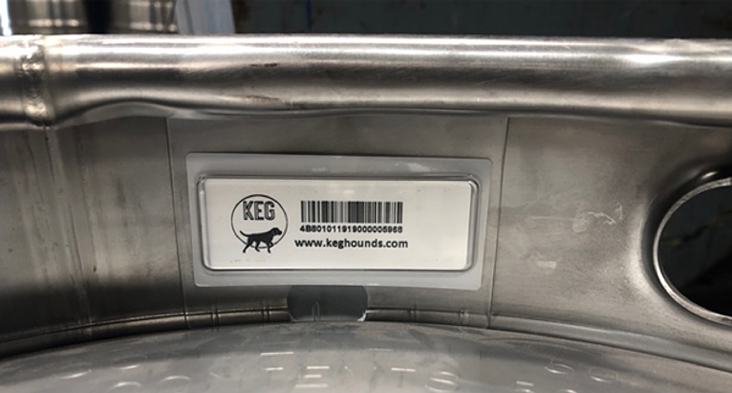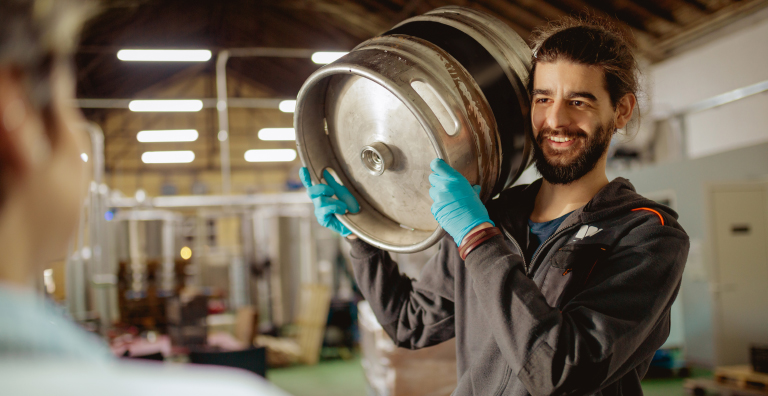How Keg Hounds Track Down Beer Kegs When They Go Rogue
Roll Out the Barrel
Losing an entire quarter’s takings as a result of lockdown has led breweries to seek new ways to boost efficiency and minimize waste. Keg loss adds millions of pounds to breweries’ annual capital costs. Effective keg management offers swift savings.
Why Do Kegs Go Astray?
Like traffic cones, beer kegs hold a curious appeal to the inebriated and often go astray after a night of revelry. Many a keg has ended its days as a DIY barbecue or been sold to a scrap metal merchant.
In addition, natural wear and tear can result in identification tags being knocked off or rendered unreadable, so empty kegs are often scooped up and returned to the wrong brewery by distributors.
A Sobering Thought
At a cost of £75, or $100 a container, keg loss is calculated to cost the global brewing industry between $300 million and $500 million each year. A sobering thought.
Between April 2019 and March 2020, the UK not-for-profit organization Keg Watch helped brewers to recover 166,625 containers, worth £12,496,725.00. In March 2020 alone, 11,060 containers were recovered, worth £829,500.00.
The Brewers Association estimates that each US brewery loses between 3–5% of its kegs each year, amounting to annual losses of $60M–$100M.
It should be noted that beer barrels remain the property of the brewery, and keeping hold of them or attempting to sell them for scrap is theft. In the early months of this year, five vehicles were stopped at British ports for carrying stolen kegs.
Asset Tracking — If You Liked It Then You Should Have Put a Tag on It
The obvious solution is to apply an ID tag to track each and every barrel that leaves the brewery. However, beer barrels have a tough life. They are often left out in the rain, jiggled about on the back of lorries, hit by forklifts, rolled down into cellars and get bashed in the lips by the bottoms of other barrels as they’re stacked. One solution is to weld a metallic tag into position, but this requires additional cost as the kegs are made from stainless steel. Furthermore, welded tags are often knocked off when barrels are stacked. Tags are also hard to read when they are wet, which is a lot of the time, and can also get worn away until they’re unreadable.
To tackle this multi-million dollar problem, US asset management company Keg Hounds approached the world’s leading industrial RFID tag provider, HID, to develop an economic asset tracking solution that was robust, waterproof and easy to attach to stainless steel kegs.
HID has spent almost two decades developing on-metal tags for the mining, exploration and automotive manufacturing industries. We enable end-to-end asset management, in-process visibility and real-time control, right down to individual assets. In the warehouse space, HID devices are used for tracking assets such as forklifts and identifying bin and aisle locations.
Our UK R&D team immediately got to work to develop a robust and cost-effective RFID tag that could be quickly and securely attached to each stainless steel chime.
The Hunt for the Perfect Keg Tag
While barcodes and radio frequency identification (RFID) are complementary rather than competing technologies, they are suited to different applications. A bottle of beer on a supermarket shelf suits a barcode, a truckload of beer kegs from different breweries warrants RFID devices.
Barcodes are suited to line-of-sight applications such as the following: if a small amount of static asset or inventory data needs to be captured, where the barcode must be readable by a human or machine, when a single item needs to be tracked and where the barcode is likely to remain legible in its operating environment.
RFID is more suitable for warehouse and logistics applications requiring a distance of 1 to 10 meters between the asset and the RFID reader, when there is no line of sight between asset and reader, when there is more asset data to capture and where multiple items need to be tracked simultaneously. RFID is also helpful when assets need to be tracked over a much larger territory and for environments where a barcode might become obscured or unreadable owing to contaminants.
Passive vs. Active RFID Tags
The RFID market is generally divided into passive devices and active devices. Passive devices signal their location and identity to the reader. Active devices not only signal their location and identity, but also transmit information about the status of assets, such as whether they are hot, cold, moving or stationary, depending upon the sensors that are integrated into the device.
Passive RFID involves labelling each asset with an integrated circuit and antenna, and communicating over wireless frequencies between the antenna and RFID reader. HID prefers to use ultra-high frequency (UHF), which offers a faster data transfer rate and longer read range than low-frequency (LF) or high-frequency (HF), and is a great match for industrial and logistic type applications. UHF RFID also offers the advantage of being able to track multiple items at once, such as items being loaded into a warehouse.
To make the tag commercially viable, HID also had to balance the application of the ideal technology against the cost of each tag. Increased development of international standards and protocols and more mainstream adoption of RFID have driven down the costs of RFID hardware and integrated circuits, making them far more affordable and reliable for warehouse applications.
On the Scent of a Solution
After settling on the use of passive RFID for the Keg Hounds tag, the HID R&D team began designing and prototyping a suitable casing and attachment method for the integrated circuit.
Our R&D team came up with a robust, waterproof passive RFID tag which can be attached inside the lip of each chime within five seconds and can be read by an RFID scanner from up to eight feet away.

The patented Keg Hounds tag clips securely to kegs without requiring welding, adhesives or special installation tools. It is IEC rated at ingress protection level 68 (IP68), indicating that it is fully dust and particle proof and highly resistant to rainwater. Each tag lasts between 10 and 20 years.
On the Trail of Missing Barrels
Keg Hounds connected our tag to its mobile app and cloud-based analytics service, which provides brewers with clear and immediate visibility of their full keg inventory and allows them to quickly track down any containers that are not returned after use.
To date, Keg Hounds has used the tags, app and analytics to help breweries in the US and UK to identify the location of over 140,000 missing kegs, saving customers more than $12.5 million in barrel losses.
Tracking Growth
The use of RFID in retail and logistics is growing rapidly. Market Research Future predicts that the RFID device market will see 7.6% compound annual growth rate (CAGR) between 2017–2023, while BCC Research predicts 13% CAGR, with the market value increasing from $7.2 billion to $13.5 billion by 2023. As pioneers of on-metal RFID tagging technology, we’ll drink to that.
For a deeper dive into how HID helps organizations track unique curved surface and other returnable transport items read our Keg Tag datasheet.
David Owen is an integrated Marketing Manager and brand builder with both professional agency and client-side experience. His client-side experience has included the Commercial Property sector with Vail Williams LLP and before that was in the conference, meeting, events and golf industry. In 2019, David joined Omni-ID (now an HID Global company). David and his family reside in the quiet countryside of Surrey England, where he likes to enjoy a round of golf.
